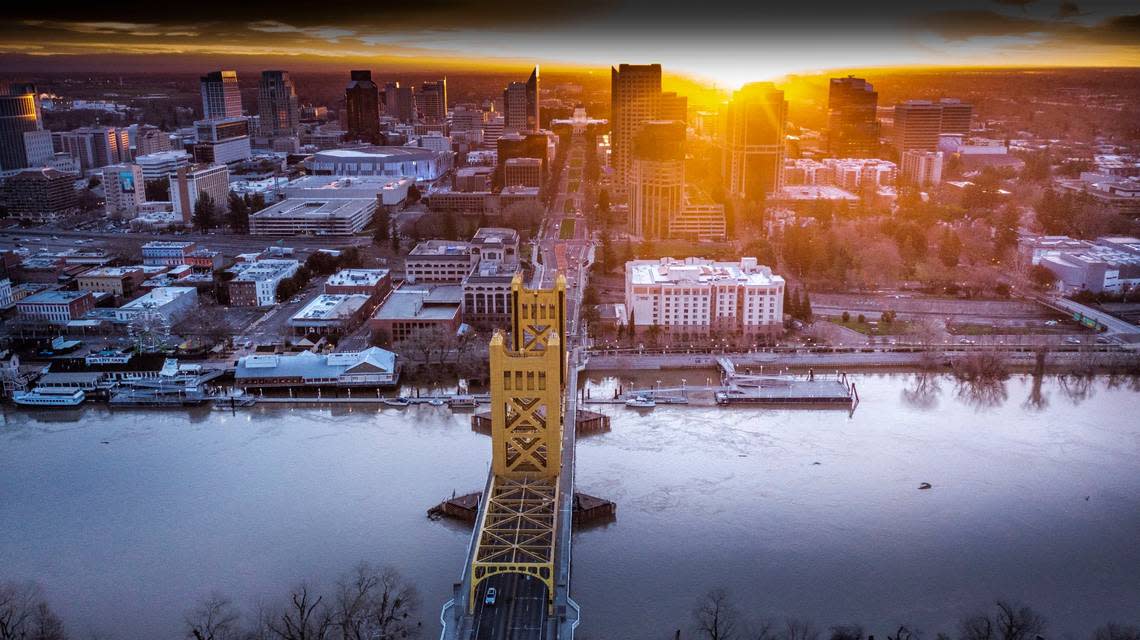Could Sacramento have an earthquake like other California cities? What to know about the risk

- Oops!Something went wrong.Please try again later.
On Thursday, a 5.5 magnitude earthquake rattled Northern California in Plumas County and could be felt as far south as Sacramento and Elk Grove. A 5.2 magnitude aftershock followed Friday morning.
But what is the risk of an earthquake really rocking the capital city? The Bee answered this reader question in 2019, as part of our Beyond Sacramento series where we directly answered community questions.
Here’s how likely it is we’d have an earthquake of our own:
The following story was originally published on June 11, 2019.
What kind of earthquake risk does Sacramento have?
Sacramento residents may breathe a sigh of relief to hear there are no major active faults under the capital region.
But while the likelihood of a significant earthquake in Sacramento is considerably lower than in the Bay Area, that doesn’t mean it can’t occur, said Richard Armstrong, a Sacramento State professor who studies earthquake engineering.
“It’s just less likely,” he said.
Still, even if Sacramento doesn’t face the same earthquake threat as other cities such as San Francisco or Los Angeles, “it has felt the effects of earthquakes in the past and likely will in the future,” according to California Geological Survey spokesman Don Drysdale.
For example, if a major earthquake were to hit near the city, the shaking could loosen sandy soil deposits, allowing water to penetrate and saturate the earth. The liquified soil could then lose its strength, cracking and moving underneath structures like levees and buildings, Drysdale said.
In downtown Sacramento and other areas near the American River or the Sacramento River, most of the land has young sedimentary river deposits and a high water table.
“Those are two of the three major ingredients that create liquefaction,” Drysdale said in an email. “The only missing ingredient for liquefaction in Sacramento is earthquake shaking.”
Liquefaction can occur even when the earthquake’s epicenter is miles away, as was the case for San Francisco’s Marina during the 1989 Loma Prieta earthquake. Though the magnitude-6.9 earthquake struck about 60 miles south, several buildings collapsed after the soil filling the waterfront liquefied.
Other earthquake risks in Sacramento include damage to unreinforced masonry buildings, such as historic brick buildings in Old Sacramento, and the performance of older high-rises, according to Drysdale.
So how bad will the shaking be?
Sacramento County could experience strong shaking during a large earthquake, but the resulting damage would be less than areas near major active faults such as the Bay Area.
Buildings specifically designed to withstand earthquakes and other “well-built” structures would likely survive a major earthquake, according to the Federal Emergency Management Agency. Shoddier buildings may have considerable damage or collapse entirely.
In 2008, the U.S. Geological Survey created animations of different earthquake scenarios along the Hayward Fault, a major active fault that runs under East Bay, including Berkeley, Oakland and San Jose.
Simulations of a strong magnitude-6.8 earthquake or more show Sacramento would likely experience significant shaking – the kind that would awaken most, and cause some dishes and windows to move or break, according to the U.S. Geological Survey.
But smaller earthquakes are far more common, and those are usually experienced without an issue in Sacramento.
Sacramentans rarely report feeling shaking beyond vibrations similar to a truck passing by, according to the U.S. Geological Survey’s Did You Feel It? crowdsourcing website.
And what about flooding?
Sacramento is widely considered the second-most flood-prone major city in the United States, after New Orleans.
Moreover, climate change has made the possibility of massive flooding at the level of the devastating 2017 Hurricane Harvey in Houston all the more likely in Sacramento.
The state and federal governments continue to pour billions of dollars into upgrading dams, levees and bypasses throughout the Sacramento and Central Valley region.
Do I need to run and get earthquake insurance?
It depends, but most in the Sacramento region do without earthquake insurance.
“The most important thing is that people look at their risks,” Sarah Sol, a spokeswoman with the California Earthquake Authority, which is responsible for about two-thirds of the state’s earthquake insurance policies.
Generally, homes built before 1980, when the state began establishing stricter state seismic building codes, are more vulnerable.
Other factors include whether the home is built on saturated soil
The average home in south Sacramento was built in 1979 and has a slab foundation, and would cost $287,000 to reconstruct. To insure the home, the annual premium could range from $100 to $826 annually, said Sarah Sol. The deductible may be between 5 and 20 percent of the reconstruction cost, depending on the plan.
Statewide, about 14 percent of people with residential insurance also have earthquake insurance, Sol said. That number is worrisome.
“They have a misconception that home insurance or a federal grant” will cover them, Sol said. “The reality is those grants don’t pay enough to rebuild homes, if they’re lucky enough to get a grant.”
How do I find out what’s threatening my neighborhood?
Residents can look up what natural disaster threatens their house using the California Governor’s Office of Emergency Services’s MyHazards website: http://www.myhazards.caloes.ca.gov.
Find your flood risk using the FEMA Flood Map: https://msc.fema.gov/portal/home

